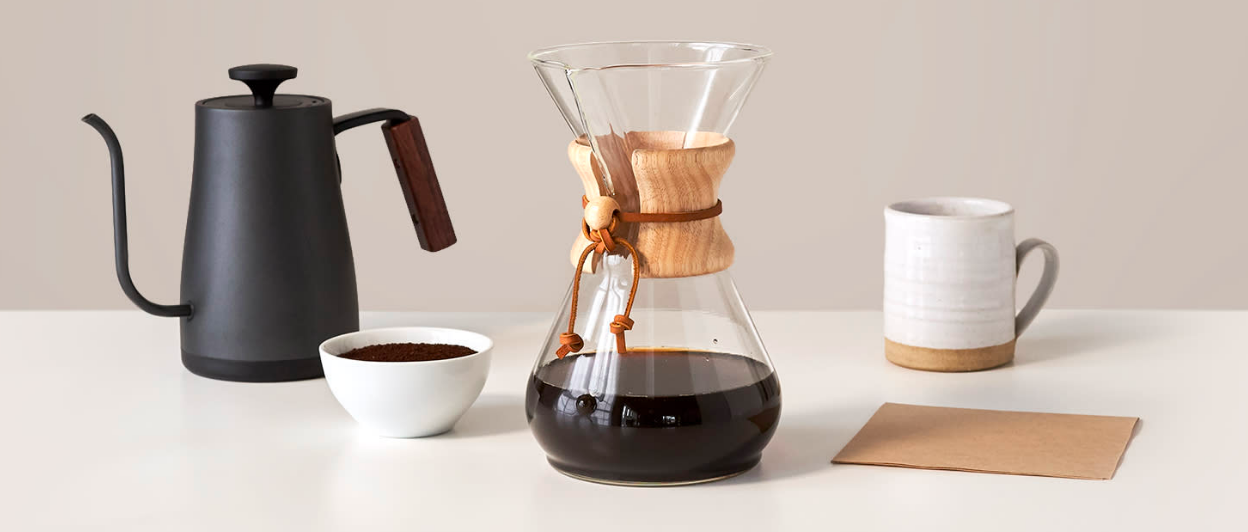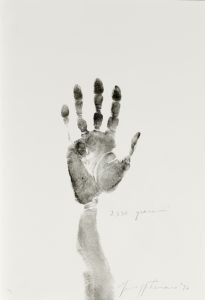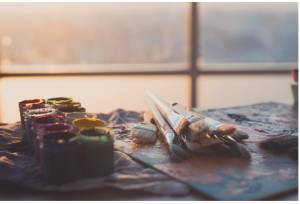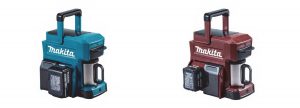Coffee is a staple part of the morning in nearly every household. Dropping fresh grounds into a filter, filling a brewer with water, and watching a pot fill with fresh, hot, aromatic coffee–all at the push of a button–is almost as pleasant as it is ubiquitous. It’s no wonder, then, with how fundamental it is to a normal daily routine, that there is an unceasing search for the perfect way to brew that all-important morning cup of coffee. While the automatic home brewer is a perfectly capable (and by far the most used) way to create a satisfying brew, there are several tools and tricks that can take anyone’s brewing game to the next level.

The Chemex
With its iconic hourglass shape and wooden neck, the only thing better than the Chemex’s aesthetic is the rich flavor in the coffee it produces. The Chemex is a subset of brewing methods known as the “pour-over.” This way of preparing coffee is nearly identical to that of an automatic home brewer. Hot water is poured over coffee grounds and through a paper filter, with one key difference: the water is poured by hand rather than by a machine.
For those looking to dip their toes into the water of manual brewing methods, its similarity to an automatic brewer and the crisp, clean coffee it produces makes the Chemex an excellent diving board. While slightly more complicated than pushing a button, it only takes a couple of tries to learn how to use a Chemex to perfection. With a 16:1 ratio (for every gram of coffee, use 16 grams of water), a medium-coarse grind setting, and a little practice perfecting a slow, steady pour, a superb cup is well within reach.
What makes the Chemex coffee so special is how the Chemex-specific filters affect the brewing process. The thick, bonded filters that fit inside the Chemex tend to hold back more of the oils and fats that can often pollute a standard cup. These oils and fats are usually responsible for the heavy, bitter flavors that most find unpleasant, leaving only the bright, sweet, crisp, and clean acids. While an essential piece of equipment, the Chemex is by no means the only innovation in home coffee brewing worth considering.
The AeroPress
Blending paper filters with the immersion method used in the French press, the Aeropress is a relatively new player to the home brewing game. Still, its versatility makes it a valuable piece of equipment. An AeroPress can quickly brew an excellent cup of coffee with far less involvement than is required of pour-over methods. The immersion aspect of the brew creates a full-bodied, vibrant flavor; you can easily control your coffee’s flavor strength by adjusting the amount of time the coffee is allowed to sit. The addition of a paper filter prevents some of the more unpleasant bitter chemicals from tainting the final cup.
Beyond black coffee, the AeroPress can produce a faux espresso for a fraction of the cost of a fully functioning espresso machine. A small, concentrated brew for use in cappuccinos and lattes is well within the capabilities of the AeroPress and requires much less finessing to create than a true espresso machine. The tools aside, there are also several considerations to make in regards to the technique to improve a coffee’s flavor,
Agitation to Reduce Bitterness
One problem plaguing many a cup of coffee is an overly acidic or overly bitter flavor that results from an uneven extraction of the coffee. A simple way to ensure all of the grounds are being extracted evenly is to stir the grounds and the water (referred to as the “slurry”) while the coffee is brewing. This can be done in either a pour-over or immersion brew and will help to get the most out of every ounce of the coffee grounds.
The Importance of Water
Since the only two ingredients in a cup of coffee are coffee grounds and water, both should be at their peak quality when being used. Water can pick up all sorts of minerals and other chemicals as it flows through any given water supply. Using filtered water will not only ensure that the flavors created are actually from the coffee and not the water, but will also create consistent brews that always taste the way they should.
With the proper tools and a few adjustments in technique, any coffee setup can quickly become one step above the rest. Whether through pour-over or immersion, little besides determination stands in the way of that perfect cup of coffee.







